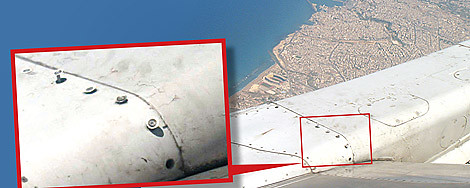Shortly after Blic published several stories about the loose screws, including detailed photographs, Jat Airways addressed the issue and did their best to address the public's concerns. The airline performed a special inspection of their fleet and reported that the problems were corrected.

It may be difficult to know all the details of the aircraft that got the most attention, a 737-300 with tail number YU-AON. According to Blic, the airline stated that the aircraft was last inspected on August 5th, and that the airline discovered the problem with the screws as a result of Blic's newspaper reports. Another passenger reported to the newspaper that another Jat Airways 737 flight, possibly involving the same aircraft, had a similar problem almost two weeks earlier on August 1st, and other passengers reported similar problems with other Jat Airways aircraft. The newspaper did not publish these other photos, but it did share with AirSafe.com News a picture of the repaired area of aircraft YU-AON. The previous AirSafe.com News article has several photos of the problem screws.

This incident, although it involved a rather small airline in Serbia, resulted in more comments than any other story previously posted by the AirSafe.com News. The general sentiment was that these loose and missing screws was not only an unsafe condition, but it may indicate that the airline may have other, more serious problems, both seen and unseen.
The two most important programs that evaluate the safety of airlines and national civil aviation authorities have different findings on the safety of Serbian civil aviation. The most recent European Commission list of airlines not allowed to fly in EU countries (dated 14 July 2009) does not include Jat Airways or any other airline from Serbia, but the FAA's International Aviation Safety Assessments (IASA) Program does not evaluate airlines, but rather the ability of a national civil aviation authority to provide safety oversight of airline operators in accordance with the minimum safety oversight standards established by the International Civil Aviation Organization (ICAO). In the FAA's most recent report from 18 December 2008, Serbia did not comply with ICAO standards, and as a result, Jat Airways would not be allowed to fly its aircraft to or from the US.
Given these mixed reviews, the average passenger may think twice before flying on this airline. AirSafe.com would be very interested in what you think about this situation, so please feel free to leave your comments about this article.




















